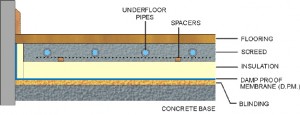Loss – extensive water damage following leak from mains pipe
Property – Bungalow with varying types of construction.
Restoration type – Target and Advanced Target Drying System
History
A leak occurred from a water pipe connection that became dislodged during a blockage of the mains water feed. This caused extensive water damage internally and a strong mal odour associated with stagnant water.
Inspection
Fire & Flood Services’ technical inspection involved a thorough analysis of the moisture conditions within the property. On site monitoring equipment was used to assist in developing a drying system that would remove incident water without the need to dig out floor screeds. Hence this reduced the disturbance to the client.
Our onsite analysis included the following,
• Moisture profiling with a hand held moisture meter
• Thermal imagery
• Relative Humidity probing
• Salts test
Findings
Our findings indicated that excessive moisture was present within the areas of the property. We concluded as follows:
1. Areas with solid floor screed could be dried with standard drying systems
2. In areas where the floor was constructed with a layer of insulation as per the diagram 1 , an advanced system was required.
Diagram 1: floor layout with layer of insulation
In the kitchen / dining area where the mains water pipe entered the property, the incident water was trapped between the damp proof membrane and insulation. Hence the finished floor level was in fact dry but stagnant water remained trapped in an area where evaporation was not taking place.
Approach
As per diagram1, it is clear that the standard drying techniques will not deal with the moisture between the insulation layer and the damp proof membrane. In order to access this moisture we attended site with a thermal imaging camera to initially determine the position of the heating pipes. When we had located the position of the pipe work we drilled a series of holes through the screed, stopping at the layer of insulation. When at the insulation layer we removed a core using a hand tool to carefully reach the damp proof membrane ensuring that this is not damaged. Throughout this process we monitored the progress of the work with the thermal imaging camera and an endoscope.
After successfully drilling and mapping the under floor structure, we installed a series of pipes into the screed and injected desiccant air under pressure directly into the floor down to the layer of DPM. This desiccant air came into contact with the trapped moisture held between the layers and was forced by the turbine action back out of the screed through the expansion gaps of the floor and into the target area. Close monitoring of the air injected into the screed and a measurement of the moisture content of the processed air returned determined when we could certify the area as dry.
Sanitisation
In order to deal with incident odours, the above process was adjusted to facilitate the injection of our sanitisation chemicals which were forced under pressure through the same drilled holes and allowed to follow the path of incident water.
Certification
Following the successful implementation of the above mentioned drying system, Fire & Flood Services certified each of the affected areas within the property as dry. This certification of dryness provided a warranty to the policy holder against the return of the incident related moisture and against the potential for secondary damage.
Conclusion
Following a review of the above procedure, Fire & Flood Services were able to save a significant amount of costs to everyone involved in the claim and enabled the policyholder to have the areas ready to be re-instated in a reduced timescale of 6 weeks.
For more information on advanced and target drying, please contact maurice@fireandflood.ie for more information.

 085 728 4300
085 728 4300